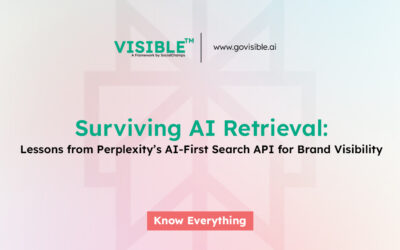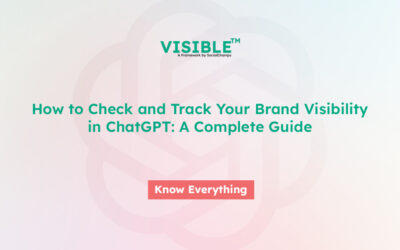The way content is discovered is undergoing a radical shift. For decades, SEO copywriting served as the go-to discipline for visibility on search engines. But with the rise of Large Language Models (LLMs), GenAI search agents, and API-first platforms, a new paradigm is emerging: one where structured, machine-readable content isn’t just preferred—it’s required.
Brands like Klarna and Adobe aren’t merely optimizing copy for SERPs—they’re engineering content systems built for AI-native discoverability. This is where Content Engineering diverges from SEO copywriting, forming a new skill stack that demands a hybrid mindset: editorial fluency meets technical schema.
From Keywords to Signals: A Paradigm Shift
Keyword stuffing and length optimization are relics of the past. What matters now is the Visibility Score of your content—how well it signals relevance, structure, and authority to GenAI models. The VISIBLE™ Framework calls this evolution Generative Engine Optimization (GEO). It shifts the focus from text that ranks on Google to structured signals that machines can parse, model, and elevate.
Traditional SEO Copywriting: Strengths and Limits
The Keyword Era
SEO copywriting gained prominence by reverse-engineering Google’s algorithm. Its key tactics—keyword density, semantic variation, backlink targeting—were optimized for search spiders. This worked when ranking meant gaming PageRank and winning the blue link battle.
But as Google itself evolves into an answer engine—and LLMs become front-door navigators—keyword-first copy has diminishing returns.
Optimizing for User, Not for Machines
Traditional SEO copywriters optimize for humans with Google as a proxy. The result? Long-form, sometimes bloated articles designed to keep users scrolling. They rarely think in entities, schemas, or content graph relationships. The output may be readable, but without structure, it limits how easily users can access that information across AI-driven surfaces.
What is Content Engineering?
Content Engineering is the discipline of structuring content so it is modular, machine-readable, and ready for programmatic delivery. It draws from technical writing, information architecture, and semantic web principles.
“Think of a content engineer as a front-end architect for AI—designing how knowledge is packaged, labeled, and surfaced.” — VISIBLE Viewpoint
Structured Content for Generative Engines
Unlike SEO copy, engineered content is designed to work across channels—not just rank on Google. It’s API-readable, semantically tagged, and built for integration into voice agents, LLMs, and knowledge bases.
Key practices include:
- Entity-first writing
- Metadata scaffolding
- Schema.org and OpenGraph embedding
- Signal-rich blocks (FAQs, data points, canonical references)
The VISIBLE™ Platform operationalizes this through Structured Signal Maps. Brands upload content, and we extract, label, and align it to GEO standards—ensuring it’s generative-ready.
Related: How Structured Content Becomes Generative-Ready
Comparing the Two Skill Sets
Human Readability vs Machine Readability
| Attribute | SEO Copywriting | Content Engineering |
|---|---|---|
| Optimized For | Human readers via SERPs | LLMs, APIs, and agents |
| Core Metric | Clickthrough Rate (CTR) | Visibility Score |
| Structure Focus | Paragraph & headline | Blocks, tags, entity modeling |
| Output Format | Long-form web pages | Modular, structured blocks |
Flat Pages vs Structured Blocks
Traditional content is flat—designed linearly. Engineers build structured blocks with modular reuse in mind. This allows a product description to power a chatbot, an AI answer box, and a B2B email, simultaneously.
The New Marketing Skill Stack
Engineers Meet Editors
The New Content Skill Stack, as defined by the VISIBLE™ Framework, blends editorial intuition with engineering logic.
- Traditional SEO: Keywords, length, readability
- Hybrid Practices: Entity extraction, structured snippets
- Structured Content Engineering: Schema tagging, API-readability, GEO™ alignment
At Shopify, product teams now collaborate directly with content engineers to model how new features are explained across docs, FAQs, and AI responses.
Tools, Tactics, and Templates
Teams are adopting:
- Semantic CMS platforms (e.g., Sanity, Contentful)
- Schema validation tools
- GEO-aligned content templates
- Visibility Score dashboards from the VISIBLE™ Platform
Why Brands Are Hiring Content Engineers
- Adobe embeds content engineers in product marketing squads to build reusable documentation blocks.
- HubSpot leverages structured content to feed its AI chat agents, not just rank blogs.
- IBM Watson requires domain content to be semantically modeled to train intent pathways.
Signals That Scale
GEO aligned content scales naturally across GenAI surfaces—ChatGPT plugins, Google’s AI Overviews, and custom RAG pipelines. Structured signals, not just smart sentences, win visibility—and deliver faster, more accurate answers to users across generative interfaces.
“In an LLM world, content without structure is content without scale.” — VISIBLE Viewpoint
GEO Friendly Content Starts with Engineers
The VISIBLE™ Platform isn’t just a CMS—it’s a Content Engineering System. With our Content Blueprint module, teams can:
- Upload raw content
- Auto-generate structured versions
- Assign Entity Depth Index scores
- Align with GEO models
Product Integration Snapshot
Our upcoming release integrates schema validators, structured block templates, and prompt optimization tools—enabling content engineers to produce AI-native pages that outperform traditional SEO.
Don’t Write for Google. Engineer for Users and AI.
SEO copywriting is no longer sufficient. In the age of GenAI, brands must produce content that is not only helpful to humans but also intelligible to machines.
Structured, engineered content isn’t anti-user—it’s pro-clarity, pro-scale, and pro-accessibility across every discovery surface: search, chat, voice, and beyond.
The winners will:
- Invest in Content Engineering
- Adopt Structured Signal Maps
- Track Visibility Scores
- Align with GEO
Is your team still writing for Google? See how the VISIBLE™ Platform engineers structured content.






